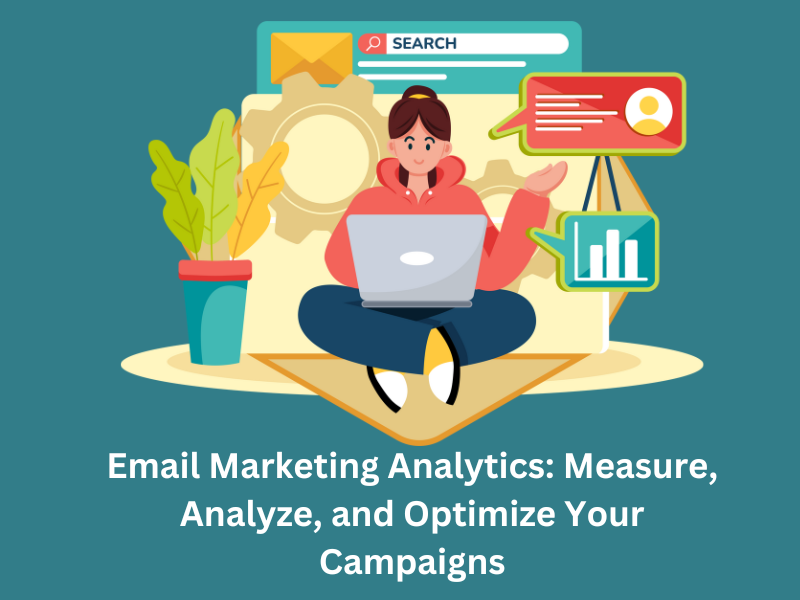Struggling to get the most out of your email marketing campaigns? You’re not alone. Many marketers send out email after email, hoping for better engagement, more clicks, and higher conversions—only to be met with disappointing results. But what if I told you that the key to turning those campaigns around lies in your data?
In today’s fast-paced digital landscape, where every email counts, measuring and analyzing your campaigns is no longer optional—it’s essential. Understanding the metrics behind your emails can make all the difference between a campaign that simply exists and one that thrives. This guide will walk you through how to measure, analyze, and optimize your email campaigns for maximum impact.
Ready to dive in? Let’s get started.
Importance of Email Marketing Analytics
Email marketing isn’t just about sending a message and hoping for the best. It’s about reaching the right people with the right content at the right time. But how do you know if your efforts are hitting the mark? This is where email marketing analytics comes into play.

Why Measuring Performance Is Crucial
Imagine driving a car without a dashboard. You wouldn’t know your speed, fuel level, or if the engine is overheating. Email marketing without analytics is much the same—you’re operating blind. Analytics provides the necessary insights to understand how your audience interacts with your emails, what’s working, and what needs improvement.
By tracking and measuring your email performance, you can:
- Identify Strengths and Weaknesses: Discover what resonates with your audience and what doesn’t.
- Optimize Future Campaigns: Use data to make informed decisions that improve open rates, click-through rates, and conversions.
- Prove ROI: Show stakeholders the value of your email marketing efforts by linking metrics to business outcomes.
Overcoming Common Challenges
Without proper analytics, marketers often struggle with:
- Unclear Performance Indicators: Not knowing which metrics truly matter.
- Data Overload: Having too much data but no clear way to interpret it.
- Missed Opportunities: Failing to leverage insights for continuous improvement.
In short, analytics is your roadmap to successful email marketing. It helps you move from guesswork to strategy, ensuring every campaign is a step towards your marketing goals.
Key Metrics to Track in Email Marketing
Not all email marketing metrics are created equal. To truly understand the performance of your campaigns, you need to focus on the key indicators that offer the most valuable insights. Let’s break down the essential metrics you should be tracking:

1. Open Rate
- What It Is: The percentage of recipients who opened your email.
- Why It Matters: Open rate is often the first sign of how well your subject line and timing are performing. If people aren’t opening your emails, the content inside doesn’t stand a chance.
Tip: Improve your open rate by crafting compelling, curiosity-inducing subject lines and experimenting with send times.
2. Click-Through Rate (CTR)
- What It Is: The percentage of recipients who clicked on a link within your email.
- Why It Matters: CTR shows how engaging your email content is and whether it effectively encourages readers to take the next step.
Tip: To boost your CTR, ensure that your call-to-action (CTA) is clear, compelling, and easy to find.
3. Conversion Rate
- What It Is: The percentage of recipients who completed the desired action, such as making a purchase or signing up for a webinar, after clicking through your email.
- Why It Matters: Conversion rate directly ties your email efforts to business outcomes, showing the effectiveness of your campaign in driving real results.
Tip: Optimize conversion rates by aligning your email content with the landing page and making the user journey as seamless as possible.
4. Bounce Rate
- What It Is: The percentage of emails that were not delivered to recipients’ inboxes.
- Why It Matters: A high bounce rate can harm your sender reputation and impact deliverability in future campaigns.
Tip: Regularly clean your email list to remove invalid or inactive email addresses and maintain a healthy bounce rate.
5. Unsubscribe Rate
- What It Is: The percentage of recipients who opt out of your email list after receiving an email.
- Why It Matters: While it’s normal to have some unsubscribes, a high rate might indicate that your content isn’t resonating with your audience or that you’re sending too many emails.
Tip: Keep an eye on your unsubscribe rate and consider adjusting your frequency or refining your content if it starts to climb.
Tools for Measuring Email Campaign Performance
To effectively measure and analyze your email marketing campaigns, you need the right tools in your arsenal. With so many options available, it’s crucial to choose tools that not only provide detailed analytics but also integrate seamlessly with your workflow. Here are some popular tools to consider:

1. Mailchimp
Overview: Mailchimp is a widely used email marketing platform known for its user-friendly interface and powerful analytics features. It offers insights into open rates, click-through rates, and more, all within an easy-to-navigate dashboard.
Pros:
- Intuitive design suitable for beginners.
- Advanced segmentation and personalization options.
- A/B testing capabilities to optimize campaigns.
Cons:
- Pricing can escalate quickly as your list grows.
- Limited customization in the lower-tier plans.
Best For: Small to medium-sized businesses looking for a comprehensive tool that’s easy to use and offers strong analytics.
2. HubSpot
Overview: HubSpot’s email marketing tool is part of its broader marketing, sales, and service platform. It provides robust analytics that integrates with CRM data, giving you a complete view of your customer interactions.
Pros:
- Seamless integration with other HubSpot tools.
- Detailed reporting that links email metrics to broader business goals.
- Automation and personalization features.
Cons:
- Can be overkill for small businesses or those not using HubSpot’s CRM.
- Higher price point compared to other tools.
Best For: Businesses that already use HubSpot’s CRM or are looking for a tool that can provide in-depth analytics across multiple marketing channels.
3. Google Analytics
Overview: While not an email marketing tool per se, Google Analytics can track the performance of your email campaigns through UTM parameters. It’s particularly useful for understanding the traffic and conversions driven by your emails.
Pros:
- Free to use with a wealth of data at your fingertips.
- Helps track the entire customer journey from email to conversion.
- Customizable reports and dashboards.
Cons:
- Steeper learning curve for beginners.
- Requires manual setup of UTM parameters to track email performance.
Best For: Marketers who want to dig deeper into how their email campaigns contribute to overall website traffic and conversions.
4. Sendinblue
Overview: Sendinblue offers email marketing with robust analytics, along with SMS marketing and automation capabilities. It’s a versatile tool that caters to various marketing needs.
Pros:
- Affordable pricing with a pay-as-you-go model.
- Strong automation and reporting features.
- Integrated SMS and email marketing.
Cons:
- Limited design customization in emails.
- The free plan has strict limits on the number of emails sent.
Best For: Small businesses and startups looking for a cost-effective solution with multi-channel capabilities.
5. Campaign Monitor
Overview: Campaign Monitor provides detailed email analytics with a focus on beautiful, responsive email design. It’s ideal for marketers who prioritize aesthetics along with performance tracking.
Pros:
- Intuitive drag-and-drop email builder.
- Detailed performance analytics with easy-to-understand reports.
- Advanced segmentation and A/B testing.
Cons:
- Fewer integrations compared to other tools.
- Higher cost for advanced features.
Best For: Design-focused marketers and businesses that need detailed analytics alongside high-quality email templates.
How to Analyze and Interpret Email Marketing Data
Collecting data is just the first step; the real power lies in analyzing and interpreting that data to drive better decision-making. Let’s walk through how you can transform your email marketing data into actionable insights.

1. Start with a Clear Objective
Before diving into your data, clarify your campaign’s goals. Are you aiming to increase brand awareness, drive sales, or boost engagement? Knowing your objective helps you focus on the most relevant metrics.
For example:
- If your goal is to increase conversions, prioritize analyzing metrics like conversion rates, click-through rates, and revenue per email.
- If you’re focused on brand awareness, open rates and social shares might be more critical.
2. Segment Your Audience
Segmentation allows you to break down your data by different audience groups. By analyzing how different segments respond to your emails, you can tailor your content more effectively. Common segmentation criteria include:
- Demographics: Age, location, gender.
- Behavioral Data: Purchase history, browsing activity.
- Engagement Levels: High-engagement vs. low-engagement subscribers.
For instance, you might discover that younger audiences prefer visual-heavy emails, while older segments respond better to detailed text.
3. Look for Patterns and Trends
Data analysis isn’t just about looking at individual metrics; it’s about spotting patterns over time. For example:
- Open Rate Trends: Are your open rates increasing or decreasing with each campaign? This could indicate the effectiveness of your subject lines and send times.
- Click-Through Patterns: Which types of content consistently get the most clicks? This insight can guide your content strategy.
By identifying these trends, you can make informed adjustments to future campaigns, ensuring they align more closely with what your audience wants.
4. Compare Against Benchmarks
Benchmarking your performance against industry standards or past campaigns helps you understand how well your emails are performing. If your open rate is lower than the industry average, it might be time to experiment with new subject lines or test different send times.
Some key benchmarks to consider:
- Industry Standards: Research average metrics for your industry to see where you stand.
- Historical Data: Compare current performance to previous campaigns to track progress over time.
5. Turn Data into Actionable Insights
Data on its own is just numbers; it’s your job to turn it into actionable insights. Here’s how:
- High Open Rates but Low CTR: If your open rate is high, but few people are clicking through, it might indicate that your email content isn’t compelling enough. Consider revising your copy or making your CTA more prominent.
- High CTR but Low Conversion Rates: If people are clicking but not converting, check the alignment between your email content and landing page. The transition should be seamless and the offer, clear.
6. Test and Optimize
Finally, use A/B testing to experiment with different elements of your emails. Test variations of subject lines, send times, CTA buttons, and email layouts to see what works best. Over time, these tests will help you fine-tune your strategy, leading to continuous improvement.
Tips for Optimizing Email Campaigns Based on Data
Once you’ve gathered and analyzed your email marketing data, the next step is to use those insights to optimize your campaigns. Here are some practical tips to help you refine your emails and boost their effectiveness.

1. Refine Your Subject Lines
Your subject line is the first impression your email makes. Use your analytics to identify which types of subject lines generate the highest open rates. Consider these strategies:
- Personalization: Including the recipient’s name or referencing past interactions can increase open rates.
- Curiosity and Urgency: Phrases like “Don’t Miss Out” or “Exclusive Offer Inside” can drive higher opens, but be careful not to overuse these tactics.
- A/B Testing: Experiment with different lengths, tones, and formats to find what resonates best with your audience.
2. Enhance Your Email Content
Content is king when it comes to email marketing. Use your click-through rate (CTR) data to see which content pieces are driving engagement. To optimize:
- Focus on Value: Ensure your emails provide valuable information, whether it’s tips, offers, or exclusive content.
- Segment Your Content: Tailor your email content to different segments of your audience. For example, new subscribers might receive educational content, while long-term subscribers get exclusive offers.
- Visual Appeal: Ensure your emails are visually engaging. Use images, videos, and clear formatting to make your content easy to digest.
3. Optimize Your Call-to-Action (CTA)
Your CTA is where the magic happens—it’s the point where your readers decide to engage further. Here’s how to optimize it:
- Clarity and Placement: Make sure your CTA is clear, concise, and stands out. Place it prominently within your email, so it’s easy to find.
- Action-Oriented Language: Use strong, action-oriented words like “Get Started,” “Claim Your Discount,” or “Learn More.”
- Test Different CTAs: Test different CTA wording, colors, and positions to see which combinations yield the best results.
4. Personalization and Segmentation
Personalized emails perform better across the board. Use your data to segment your audience and send targeted emails that cater to specific interests or behaviors. Here’s how:
- Behavioral Segmentation: Send different emails to customers based on their past behavior, such as purchase history or browsing habits.
- Dynamic Content: Use dynamic content blocks within your emails to show different images or offers based on the recipient’s preferences or location.
- Triggered Emails: Set up automated emails that are triggered by specific actions, such as signing up for a newsletter or abandoning a cart.
5. Leverage A/B Testing
A/B testing allows you to experiment with different elements of your emails to see what works best. Focus on testing:
- Subject Lines: Test variations in wording, length, and tone.
- Email Content: Compare different versions of email layouts, content lengths, or formats.
- Send Times: Experiment with different times of day or days of the week to find out when your audience is most responsive.
6. Continuously Improve with Data
Optimization is an ongoing process. Regularly review your email analytics to spot new opportunities for improvement. Consider setting up periodic reviews of your campaigns to refine your strategies continually. Pay attention to:
- Long-Term Trends: Watch how your metrics change over time and adjust your approach as needed.
- User Feedback: Encourage feedback from your audience, and use it to make your emails more relevant and engaging.
- Emerging Best Practices: Stay up-to-date with the latest email marketing trends and tools to keep your campaigns fresh and effective.
Common Mistakes in Email Marketing Analytics
Even with the best tools and intentions, it’s easy to make mistakes when analyzing email marketing data. These errors can lead to misguided decisions that hurt your campaign’s performance. Let’s explore some of the most common pitfalls and how to avoid them.

1. Misinterpreting Data
One of the biggest mistakes is drawing the wrong conclusions from your data. This often happens when:
- Focusing on Vanity Metrics: Metrics like open rates and click-through rates are important, but they don’t tell the whole story. For example, a high open rate is great, but if conversions are low, the content or CTA may not be effective.
- Overreacting to Outliers: Sometimes a campaign may have an unusually high or low performance due to factors outside your control, like a holiday season or a technical issue. Don’t let one-off events skew your overall strategy.
Avoidance Tip: Always look at the bigger picture and analyze trends over time rather than focusing on single data points. Pair metrics with context to understand the real implications.
2. Ignoring Key Metrics
While it’s tempting to focus only on the metrics that show positive results, ignoring other key metrics can be costly. For instance:
- Bounce Rate: High bounce rates can signal problems with your email list quality, yet they’re often overlooked.
- Unsubscribe Rate: If you’re losing subscribers at a high rate, it’s a sign that your content or frequency might be off. Ignoring this metric could lead to a shrinking email list.
Avoidance Tip: Regularly review all your key metrics, even those that may not look favorable. This comprehensive approach will help you address issues before they escalate.
3. Relying Too Heavily on One Metric
Another common mistake is putting too much emphasis on a single metric, like open rate or CTR, without considering others. This can lead to:
- Skewed Priorities: For example, if you focus solely on open rates, you might prioritize subject lines over content quality, resulting in lower conversions.
- Incomplete Analysis: Focusing on one metric doesn’t give you the full picture. A balanced view across several metrics is necessary to understand overall campaign health.
Avoidance Tip: Use a holistic approach by considering multiple metrics together. For example, examine how your open rates, click-through rates, and conversion rates interact with each other to give you a fuller understanding.
4. Not Segmenting Data
Lumping all your subscribers into one group when analyzing data can lead to misleading insights. For example:
- Different Behaviors in Segments: A segment of loyal customers might respond very differently to your emails compared to new subscribers. Without segmentation, these differences are masked, making it hard to optimize effectively.
Avoidance Tip: Always segment your data by key criteria like demographics, past behavior, and engagement levels. This allows you to tailor your strategy to each group’s unique preferences and needs.
5. Failing to Act on Insights
Finally, even the best analysis is worthless if you don’t act on the insights it provides. Common reasons for this include:
- Data Overwhelm: With so much data available, it can be challenging to know where to start. This can lead to inaction or making changes that don’t address the real issues.
- Fear of Change: Some marketers are hesitant to change their strategy, especially if they’ve had some success in the past.
Avoidance Tip: Prioritize actionable insights and start with small, manageable changes. Regularly test and adjust your strategy based on the data, and don’t be afraid to pivot if something isn’t working.
Case Studies of Successful Email Marketing Optimization
Sometimes, the best way to learn is by example. Let’s look at a few real-world case studies where businesses successfully optimized their email marketing campaigns using data-driven insights.

1. Airbnb: Personalization at Scale
Challenge: Airbnb wanted to increase engagement among its vast user base, but sending the same email to everyone wasn’t effective. They needed a way to deliver personalized content at scale.
Solution: Airbnb implemented advanced segmentation and personalization strategies based on user behavior, preferences, and location. For example, they sent tailored emails showcasing properties in locations users had previously searched for or nearby destinations.
Results: This personalized approach led to a significant increase in open rates and click-through rates. By using data to deliver relevant content, Airbnb was able to deepen user engagement and encourage repeat bookings.
Key Takeaway: Personalization isn’t just a buzzword—it’s a proven strategy for increasing email effectiveness. Use your data to segment your audience and tailor your emails to their specific interests and behaviors.
2. BuzzFeed: A/B Testing for Content Optimization
Challenge: BuzzFeed, known for its viral content, wanted to maximize engagement with its email newsletters. They needed to determine what types of content and email formats resonated most with their audience.
Solution: BuzzFeed conducted extensive A/B testing on various elements of their emails, including subject lines, content layout, and the types of stories featured. They tested different combinations to see what generated the highest engagement.
Results: Through A/B testing, BuzzFeed discovered that listicles and quizzes performed exceptionally well. By focusing on these types of content in their emails, they saw a notable increase in click-through rates and overall engagement.
Key Takeaway: Continuous A/B testing can uncover valuable insights about what works best for your audience. Don’t be afraid to experiment with different elements of your emails to find the most effective combinations.
3. Grammarly: Leveraging User Data for Re-Engagement
Challenge: Grammarly faced the challenge of re-engaging inactive users who had stopped using their writing assistant tool. They needed a strategy to bring these users back on board.
Solution: Grammarly analyzed user data to identify patterns of inactivity. They then launched a re-engagement campaign targeting these users with personalized emails. These emails included usage statistics, reminders of Grammarly’s benefits, and incentives like free premium trials.
Results: The re-engagement campaign was a success, with many users returning to the platform. Grammarly saw a significant reduction in churn rates and an increase in premium subscriptions.
Key Takeaway: Re-engagement campaigns can effectively win back inactive users. Use your data to identify at-risk subscribers and craft personalized messages that remind them of your value.
4. Charity: Water: Storytelling to Drive Donations
Challenge: Charity: Water, a nonprofit organization, needed to boost donations through their email campaigns. They wanted to connect emotionally with donors and highlight the impact of their contributions.
Solution: The organization used storytelling in their emails to share powerful narratives about the people and communities benefiting from their projects. They combined this with data-driven segmentation to target specific donor groups with relevant stories.
Results: By telling compelling stories and showing tangible results, Charity: Water saw a significant increase in donor engagement and donations. Their email campaigns helped build a stronger connection with their supporters.
Key Takeaway: Emotional storytelling, when combined with data-driven targeting, can significantly enhance the impact of your email campaigns. Use your data to find the stories that will resonate most with different segments of your audience.
Future Trends in Email Marketing Analytics
As technology continues to evolve, so does the field of email marketing analytics. Staying ahead of these trends can give you a competitive edge, helping you refine your strategies and achieve even better results. Here are some key trends to watch for in the future of email marketing analytics:

1. Predictive Analytics
Predictive analytics uses historical data, machine learning, and AI to forecast future behaviors. In email marketing, this means you can predict:
- Customer Behavior: Anticipate what types of emails will engage specific segments based on past interactions.
- Churn Rates: Identify subscribers at risk of unsubscribing and target them with re-engagement campaigns before they leave.
- Optimal Send Times: Predict the best times to send emails for maximum engagement.
As more businesses adopt predictive analytics, expect to see campaigns that are more personalized and better timed, leading to higher engagement and conversions.
2. AI-Driven Content Optimization
Artificial Intelligence is revolutionizing the way email content is created and optimized. AI can:
- Generate Subject Lines: Create and test different subject lines based on what’s most likely to drive opens.
- Personalize Content: Automatically adjust email content based on user preferences and behavior, ensuring that each subscriber gets the most relevant message.
- A/B Testing at Scale: Run numerous A/B tests simultaneously to quickly determine the most effective email elements.
With AI, marketers can fine-tune their emails with precision, making data-driven decisions faster and more effectively than ever before.
3. Enhanced Privacy and Data Protection
With growing concerns around data privacy, regulations like GDPR and CCPA are becoming more stringent. This trend will continue, with a focus on:
- Consent Management: Ensuring that subscribers have clearly opted in and understand how their data will be used.
- Data Minimization: Collecting only the data necessary for effective email marketing and securing it against breaches.
- Transparent Analytics: Providing subscribers with clear insights into how their data is used, which can build trust and loyalty.
Marketers will need to balance the use of data with respecting privacy, ensuring compliance with new regulations while still delivering effective campaigns.
4. Integration with Omnichannel Marketing
Email marketing will increasingly integrate with other digital marketing channels, providing a more seamless experience across platforms. This trend includes:
- Unified Analytics: Combining data from email, social media, and other channels to get a holistic view of customer behavior.
- Cross-Channel Campaigns: Coordinating email marketing with SMS, push notifications, and social media to create consistent messaging.
- Customer Journey Mapping: Using data from multiple channels to map out the entire customer journey, identifying key touchpoints where email can be most effective.
As omnichannel marketing grows, the ability to analyze and optimize across all channels will become essential.
5. Real-Time Analytics
In the near future, marketers will increasingly rely on real-time analytics to make on-the-fly adjustments to their email campaigns. Real-time data allows you to:
- Monitor Campaign Performance: See how your emails are performing immediately after they’re sent, enabling quick adjustments if necessary.
- Respond to Trends: Act on emerging trends or unexpected events as they happen, tailoring your messaging to current circumstances.
- Dynamic Content Updates: Modify email content based on real-time data, such as weather changes, stock levels, or breaking news.
The ability to act in real-time will make campaigns more responsive and relevant, increasing their overall effectiveness.
Conclusion
In the fast-paced world of digital marketing, email remains one of the most powerful tools at your disposal. But to truly harness its potential, you need to go beyond just sending emails—you need to measure, analyze, and optimize your campaigns. By focusing on key metrics, leveraging the right tools, and avoiding common pitfalls, you can transform your email marketing efforts into a data-driven powerhouse that consistently delivers results.
From refining your subject lines and content to personalizing your messages and running strategic A/B tests, the steps you take today will shape the success of your campaigns tomorrow. And as trends like predictive analytics, AI-driven optimization, and real-time data analysis continue to evolve, staying ahead of the curve will ensure you’re always delivering relevant, impactful emails to your audience.
So, what’s next? Start applying the tips and strategies outlined in this guide to your own campaigns. Whether you’re new to email marketing analytics or looking to take your efforts to the next level, the key is to keep learning, testing, and refining. Remember, every piece of data is a clue to how you can improve—and every improvement is a step toward greater engagement and ROI.









